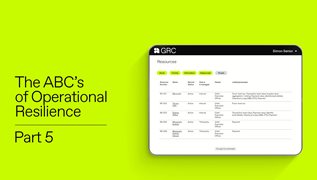Four ways GRC can support operational stability
Well-targeted GRC strategies can help organizations break down silos, improve communication and reduce interdepartmental tensions. Done improperly, however, GRC could make things worse. Here’s what to do – and what to avoid.
By AnsaradaWed Apr 20 2022CEO-CFO, Audits and compliance, Governance Risk and Compliance

A governance, risk and compliance (GRC) strategy is more than just a policy that reminds staff to act ethically. Instead, it’s a way for your organization to manage interdepartmental risk and help staff members do their jobs. It’s a powerful tool for breaking down barriers and improving operational efficiency.
A strong GRC strategy helps your people act ethically and make the best decisions for your business. It’s a way for individuals to apply their domain expertise to risk and compliance issues. Vitally, it’s about fostering ownership rather than leaving GRC advocacy exclusively to compliance professionals.
When done poorly, GRC can overload staff with complicated and inefficient reporting processes, while leaving existing silos in place – or even reinforcing them.
The key is to make education the bedrock of your strategy, embedding risk management and compliance into your culture – not making it an added burden or an afterthought.
Start by ensuring that everyone in your organization is speaking the same language. This will enhance your ability to work together by removing department-specific jargon for a process that is repeated elsewhere in the business.
The first part of the equation, governance, refers to the way organizations effectively implement cross-organizational processes and procedures to comply with industry requirements and regulations. What it actually looks like can vary greatly but generally it’s about ensuring that everyone is complying with business requirements and working toward the same business goals.
Incorporating risk into your corporate thinking comes down to two considerations: how you monitor and how you respond. Instead of using top-down mandates, if you enable staff to identify and respond to risk – including building solutions collaboratively – you can improve employee buy-in. You ultimately want to empower your employees to collectively make good decisions without copious oversight.
There are people in your organization who have valuable technical and institutional knowledge. Yet, because of the nature of their roles, they may not have a reason to communicate across departments. A GRC strategy can harness and share that knowledge throughout the organization. This has the added benefit of ensuring that knowledge doesn’t leave an organization when an individual does. It also makes the individual feel like their contributions are valued.
Legal and regulatory compliance can be the most challenging aspect of GRC because it’s essential to get it right – and it involves shifting targets as legislation and regulations change. Failure to comply can have significant legal, financial and reputational implications. Updating policies and training is essential, but if you don’t have organizational buy-in it could end up just being white noise.
While GRC can help your organization improve communication, when improperly implemented it can cause significant problems. If the data across departments isn’t integrated in a way that reflects the unified vision of the executive team, it can lead to a culture of non-compliance simply because expectations are not clear. Similarly, a patchwork approach to GRC can allow relevant information to slip through, leaving you exposed to risks and inefficiencies.
Automating some of your processes can provide insights. Relying on legacy tools and systems that are spread across many platforms – spreadsheets, emails, phone calls – can result in a lack of accountability and no audit trail. You’re left open to risks from errors or even fraud.
You can make it easier to work as a unified team by proactively addressing your GRC challenges and making GRC a core capability of your organization.
The more manual effort required to fulfil GRC operational requirements, the more problems you’ll encounter. From time-consuming processes to errors, manual processes can be inefficient and a waste of your human capital.
Your organization’s GRC aptitude is only as strong as its weakest link. Great systems won’t matter if there isn’t a culture to support it.
A sound GRC strategy is one that recognizes that your business is constantly growing and changing. As you identify new risks, your strategy needs to shift based on new analysis.
A strong GRC strategy helps your people act ethically and make the best decisions for your business. It’s a way for individuals to apply their domain expertise to risk and compliance issues. Vitally, it’s about fostering ownership rather than leaving GRC advocacy exclusively to compliance professionals.
When done poorly, GRC can overload staff with complicated and inefficient reporting processes, while leaving existing silos in place – or even reinforcing them.
The key is to make education the bedrock of your strategy, embedding risk management and compliance into your culture – not making it an added burden or an afterthought.
Incorporating GRC starts with understanding
Start by ensuring that everyone in your organization is speaking the same language. This will enhance your ability to work together by removing department-specific jargon for a process that is repeated elsewhere in the business.
The first part of the equation, governance, refers to the way organizations effectively implement cross-organizational processes and procedures to comply with industry requirements and regulations. What it actually looks like can vary greatly but generally it’s about ensuring that everyone is complying with business requirements and working toward the same business goals.
Incorporating risk into your corporate thinking comes down to two considerations: how you monitor and how you respond. Instead of using top-down mandates, if you enable staff to identify and respond to risk – including building solutions collaboratively – you can improve employee buy-in. You ultimately want to empower your employees to collectively make good decisions without copious oversight.
There are people in your organization who have valuable technical and institutional knowledge. Yet, because of the nature of their roles, they may not have a reason to communicate across departments. A GRC strategy can harness and share that knowledge throughout the organization. This has the added benefit of ensuring that knowledge doesn’t leave an organization when an individual does. It also makes the individual feel like their contributions are valued.
Legal and regulatory compliance can be the most challenging aspect of GRC because it’s essential to get it right – and it involves shifting targets as legislation and regulations change. Failure to comply can have significant legal, financial and reputational implications. Updating policies and training is essential, but if you don’t have organizational buy-in it could end up just being white noise.
While GRC can help your organization improve communication, when improperly implemented it can cause significant problems. If the data across departments isn’t integrated in a way that reflects the unified vision of the executive team, it can lead to a culture of non-compliance simply because expectations are not clear. Similarly, a patchwork approach to GRC can allow relevant information to slip through, leaving you exposed to risks and inefficiencies.
Automating some of your processes can provide insights. Relying on legacy tools and systems that are spread across many platforms – spreadsheets, emails, phone calls – can result in a lack of accountability and no audit trail. You’re left open to risks from errors or even fraud.
Four steps towards functioning as a unified team
You can make it easier to work as a unified team by proactively addressing your GRC challenges and making GRC a core capability of your organization.
1. Break down silos
When developing your GRC strategy, create a clear framework that motivates everyone in the organization.- Clear communication is essential. You don’t want departments operating independently, developing diverse processes which can cause reporting or compliance gaps.
- Your GRC strategy should include a framework that sets out shared language and expectations. This can prevent instances where departments are working toward individual goals without considering the needs of the larger organization.
- Use training session to educate staff about the new processes. It will bring together staff from different departments to encourage cross-organizational collaboration.
2. Automate processes
The more manual effort required to fulfil GRC operational requirements, the more problems you’ll encounter. From time-consuming processes to errors, manual processes can be inefficient and a waste of your human capital.
- Manual reporting makes it hard to aggregate, analyze and visualize your data.
- By automating GRC processes, you’ll be able to save time, get more timely insights and be able to identify and anticipate potential issues.
- Review the tools you are using and reduce reliance on outdated or bespoke systems in favour of a comprehensive solution that incorporates a variety of metrics.
3. Build a culture around GRC
Your organization’s GRC aptitude is only as strong as its weakest link. Great systems won’t matter if there isn’t a culture to support it.
- Constantly update your framework, treating it like a living document. Make reactive changes as necessitated by regulatory or operational shifts to improve process for staff. Recognize and reflect the strengths and weaknesses of your people.
- Ensure that every action that you take aligns with your strategy and cull anything that’s extraneous. Anything non-essential is going to add a burden to your analysts and the people doing the reporting.
- Reward positive employee behaviours to encourage a culture where compliance is celebrated and not a burden.
4. Embrace continuous improvement
A sound GRC strategy is one that recognizes that your business is constantly growing and changing. As you identify new risks, your strategy needs to shift based on new analysis.
- Cloud-based software solutions have made it easier to implement GRC frameworks.
- Digital solutions are usually embraced by workers as their interfaces are similar to other technologies that they use in their work and life.
- Find a vendor who can help you streamline your compliance and risk requirements, connecting the various areas of your organization.
TriLine GRC by Ansarada
Learn more about how GRC software can help you break down organizational silos to build a more risk-aware and compliant business. Book a demo of TriLine GRC by Ansarada today.
Book a demo.jpg?height=180)

